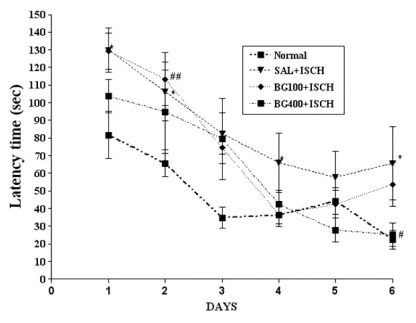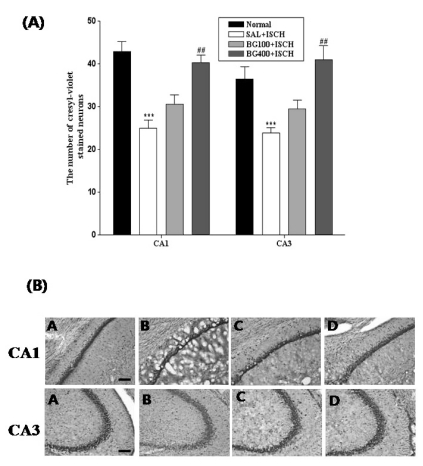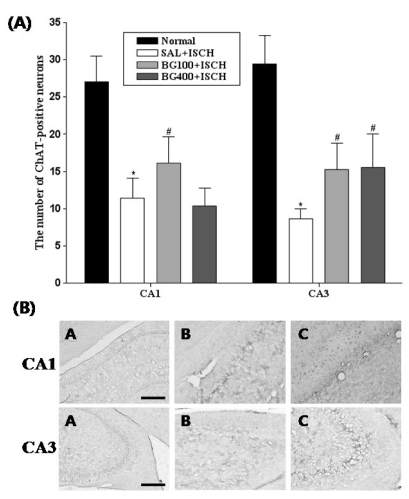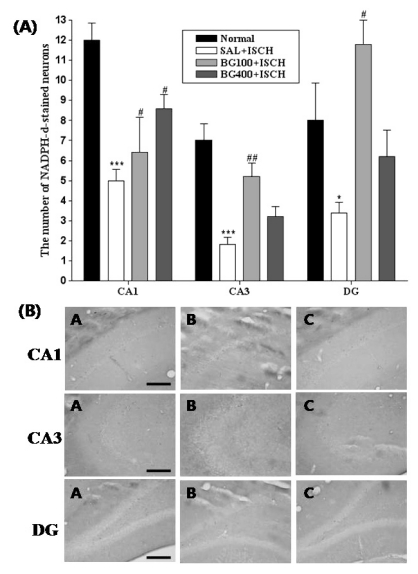Korean J Physiol Pharmacol.
2011 Dec;15(6):333-338. 10.4196/kjpp.2011.15.6.333.
The Protective Effect of Black Ginseng Against Transient Focal Ischemia-induced Neuronal Damage in Rats
- Affiliations
-
- 1Acupuncture and Meridian Science Research Center, College of Oriental Medicine, Kyung Hee University, Seoul 130-701, Korea. ishim@khu.ac.kr
- 2Department of Integrative Medicine and the Research Center of Behavioral Medicine, College of Medicine, The Catholic University of Korea, Seoul 137-701, Korea.
- KMID: 2285419
- DOI: http://doi.org/10.4196/kjpp.2011.15.6.333
Abstract
- Black ginseng (BG) has been widely used as herbal treatment for improving physiological function. In order to investigate the neuroprotective action of this herbal medicine, we examined the influence of BG on the learning and memory of rats using the Morris water maze, and we studied the effects of BG on the central cholinergic system and neural nitric oxide synthesis in the hippocampus of rats with neuronal and cognitive impairment. After middle cerebral artery occlusion was applied for 2h, the rats were administered BG (100 or 400 mgkg(-1), p.o.) daily for 2 weeks, followed by training and performance of the Morris water maze test. The rats with ischemic insults showed impaired learning and memory on the tasks. Treatment with BG produced improvement in the escape latency to find the platform. Further, the BG groups showed a reduced loss of cholinergic immunoreactivity and nicotinamide adenine dinucleotide phosphate-diaphorase (NADPH-d)-positive neurons in the hippocampus compared to that of the ISC group. These results demonstrated that BG has a protective effect against ischemia-induced neuronal and cognitive impairment. Our results suggest that BG might be useful for the treatment of vascular dementia.
Keyword
MeSH Terms
Figure
Reference
-
1. Klijn CJ, Hankey GJ. American Stroke Association and European Stroke Initiative. Management of acute ischaemic stroke: new guidelines from the American Stroke Association and European Stroke Initiative. Lancet Neurol. 2003; 2:698–701. PMID: 14572738.
Article2. Fawcett JW, Asher RA. The glial scar and central nervous system repair. Brain Res Bull. 1999; 49:377–391. PMID: 10483914.
Article3. Silver J, Miller JH. Regeneration beyond the glial scar. Nat Rev Neurosci. 2004; 5:146–156. PMID: 14735117.
Article4. Wang Q, Sun AY, Simonyi A, Kalogeris TJ, Miller DK, Sun GY, Korthuis RJ. Ethanol preconditioning protects against ischemia/reperfusion-induced brain damage: role of NADPH oxidase-derived ROS. Free Radic Biol Med. 2007; 43:1048–1060. PMID: 17761301.
Article5. Mulvey JM, Dorsch NW, Mudaliar Y, Lang EW. Multimodality monitoring in severe traumatic brain injury: the role of brain tissue oxygenation monitoring. Neurocrit Care. 2004; 1:391–402. PMID: 16174941.
Article6. Gillis CN. Panax ginseng pharmacology: a nitric oxide link? Biochem Pharmacol. 1997; 54:1–8. PMID: 9296344.
Article7. O'Hara M, Kiefer D, Farrell K, Kemper K. A review of 12 commonly used medicinal herbs. Arch Fam Med. 1998; 7:523–536. PMID: 9821826.8. Lee JH, Shen GN, Kim EK, Shin JH, Myung CS, Oh HJ, Kim DH, Roh SS, Cho W, Seo YB, Park YJ, Kang CW, Song GY. Preparation of black ginseng and its antitumor activity. Korean J Orient Physiol Pathol. 2006; 20:951–956.9. Song GY, Oh HJ, Roh SS, Seo YB, Park YJ, Myung CS. Effect of black ginseng on body weight and lipid profiles in male rats fed normal diets. Korean J Pharmacogn. 2006; 50:381–385.10. Yun TK. Experimental and epidemiological evidence on non-organ specific cancer preventive effect of Korean ginseng and identification of active compounds. Mutat Res. 2003; 523-524:63–74. PMID: 12628504.
Article11. Kim SN, Ha YW, Shin H, Son SH, Wu SJ, Kim YS. Simultaneous quantification of 14 ginsenosides in Panax ginseng C.A. Meyer (Korean red ginseng) by HPLC-ELSD and its application to quality control. J Pharm Biomed Anal. 2007; 45:164–170. PMID: 17560064.
Article12. Baek NI, Kim DS, Lee YH, Park JD, Lee CB, Kim SI. Ginsenoside Rh4, a genuine dammarane glycoside from Korean red ginseng. Planta Med. 1996; 62:86–87. PMID: 8720394.
Article13. Yun TK. Experimental and epidemiological evidence of the cancer-preventive effects of Panax ginseng C.A. Meyer. Nutr Rev. 1996; 54:S71–S81. PMID: 9110579.14. Kim KT, Yoo KM, Lee JW, Eom SH, Hwang IK, Lee CY. Protective effect of steamed American ginseng (Panax quinquefolius L.) on V79-4 cells induced by oxidative stress. J Ethnopharmacol. 2007; 111:443–450. PMID: 17276636.
Article15. Kang KS, Kim HY, Yamabe N, Nagai R, Yokozawa T. Protective effect of sun ginseng against diabetic renal damage. Biol Pharm Bull. 2006; 29:1678–1684. PMID: 16880625.
Article16. Wargovich MJ. Colon cancer chemoprevention with ginseng and other botanicals. J Korean Med Sci. 2001; 16(Suppl):S81–S86. PMID: 11748382.
Article17. Sun BS, Gu LJ, Fang ZM, Wang CY, Wang Z, Lee MR, Li Z, Li JJ, Sung CK. Simultaneous quantification of 19 ginsenosides in black ginseng developed from Panax ginseng by HPLC-ELSD. J Pharm Biomed Anal. 2009; 50:15–22. PMID: 19394786.
Article18. D'Hooge R, De Deyn PP. Applications of the Morris water maze in the study of learning and memory. Brain Res Brain Res Rev. 2001; 36:60–90. PMID: 11516773.19. Scherer-Singler U, Vincent SR, Kimura H, McGeer EG. Demonstration of a unique population of neurons with NADPH-diaphorase histochemistry. J Neurosci Methods. 1983; 9:229–234. PMID: 6363828.
Article20. Kim IB, Oh SJ, Chun MH. Neuronal nitric oxide synthase immunoreactive neurons in the mammalian retina. Microsc Res Tech. 2000; 50:112–123. PMID: 10891875.
Article21. Paxinos G, Watson C, Pennisi M, Topple A. Bregma, lambda and the interaural midpoint in stereotaxic surgery with rats of different sex, strain and weight. J Neurosci Methods. 1985; 13:139–143. PMID: 3889509.
Article22. Lee B, Choi Y, Kim H, Kim SY, Hahm DH, Lee HJ, Shim I. Protective effects of methanol extract of Acori graminei rhizoma and Uncariae Ramulus et Uncus on ischemia-induced neuronal death and cognitive impairments in the rat. Life Sci. 2003; 74:435–450. PMID: 14609722.
Article23. Torres JB, Assunção J, Farias JA, Kahwage R, Lins N, Passos A, Quintairos A, Trévia N, Diniz CW. NADPH-diaphorase histochemical changes in the hippocampus, cerebellum and striatum are correlated with different modalities of exercise and watermaze performances. Exp Brain Res. 2006; 175:292–304. PMID: 16763833.
Article24. Susswein AJ, Katzoff A, Miller N, Hurwitz I. Nitric oxide and memory. Neuroscientist. 2004; 10:153–162. PMID: 15070489.
Article25. Matsunaga K, Mukasa H. The effect of alcohol on the human memory. Arukoru Kenkyuto Yakubutsu Ison. 1986; 21:64–73. PMID: 3718332.26. Luine VN, Jacome LF, Maclusky NJ. Rapid enhancement of visual and place memory by estrogens in rats. Endocrinology. 2003; 144:2836–2844. PMID: 12810538.
Article27. Sato T, Teramoto T, Tanaka K, Ohnishi Y, Irifune M, Nishikawa T. Effects of ovariectomy and calcium deficiency on learning and memory of eight-arm radial maze in middle-aged female rats. Behav Brain Res. 2003; 142:207–216. PMID: 12798282.
Article28. Du JY, Li XY, Zhuang Y, Wu XY, Wang T. Effects of acute mild and moderate hypoxia on human short memory. Space Med Med Eng (Beijing). 1999; 12:270–273. PMID: 11542709.29. Iadecola C. Regulation of the cerebral microcirculation during neural activity: is nitric oxide the missing link? Trends Neurosci. 1993; 16:206–214. PMID: 7688160.
Article30. Medina JH, Izquierdo I. Retrograde messengers, long-term potentiation and memory. Brain Res Brain Res Rev. 1995; 21:185–194. PMID: 8866674.
Article31. Hawkins RD, Son H, Arancio O. Nitric oxide as a retrograde messenger during long-term potentiation in hippocampus. Prog Brain Res. 1998; 118:155–172. PMID: 9932440.32. Zorumski CF, Izumi Y. Modulation of LTP induction by NMDA receptor activation and nitric oxide release. Prog Brain Res. 1998; 118:173–182. PMID: 9932441.33. Bartus RT, Dean RL 3rd, Beer B, Lippa AS. The cholinergic hypothesis of geriatric memory dysfunction. Science. 1982; 217:408–414. PMID: 7046051.
Article34. Coyle JT, Price DL, DeLong MR. Alzheimer's disease: a disorder of cortical cholinergic innervation. Science. 1983; 219:1184–1190. PMID: 6338589.
Article35. Waite JJ, Holschneider DP, Scremin OU. Selective immunotoxin-induced cholinergic deafferentation alters blood flow distribution in the cerebral cortex. Brain Res. 1999; 818:1–11. PMID: 9914432.
Article36. Bredt DS, Snyder SH. Nitric oxide mediates glutamate-linked enhancement of cGMP levels in the cerebellum. Proc Natl Acad Sci USA. 1989; 86:9030–9033. PMID: 2573074.
Article37. Dawson TM, Bredt DS, Fotuhi M, Hwang PM, Snyder SH. Nitric oxide synthase and neuronal NADPH diaphorase are identical in brain and peripheral tissues. Proc Natl Acad Sci USA. 1991; 88:7797–7801. PMID: 1715581.
Article38. Hope BT, Michael GJ, Knigge KM, Vincent SR. Neuronal NADPH diaphorase is a nitric oxide synthase. Proc Natl Acad Sci USA. 1991; 88:2811–2814. PMID: 1707173.
Article39. Faber-Zuschratter H, Seidenbecher T, Reymann K, Wolf G. Ultrastructural distribution of NADPH-diaphorase in the normal hippocampus and after long-term potentiation. J Neural Transm. 1996; 103:807–817. PMID: 8872865.
Article40. Zhuo M, Laitinen JT, Li XC, Hawkins RD. On the respective roles of nitric oxide and carbon monoxide in long-term potentiation in the hippocampus. Learn Mem. 1998; 5:467–480. PMID: 10489262.
Article41. Daniel H, Hemart N, Jaillard D, Crepel F. Long-term depression requires nitric oxide and guanosine 3':5' cyclic monophosphate production in rat cerebellar Purkinje cells. Eur J Neurosci. 1993; 5:1079–1082. PMID: 7506617.42. Daniel H, Levenes C, Crépel F. Cellular mechanisms of cerebellar LTD. Trends Neurosci. 1998; 21:401–407. PMID: 9735948.
Article43. Calabresi P, Centonze D, Gubellini P, Marfia GA, Pisani A, Sancesario G, Bernardi G. Synaptic transmission in the striatum: from plasticity to neurodegeneration. Prog Neurobiol. 2000; 61:231–265. PMID: 10727775.
Article44. Bon CL, Garthwaite J. On the role of nitric oxide in hippocampal long-term potentiation. J Neurosci. 2003; 23:1941–1948. PMID: 12629199.
Article45. Susswein AJ, Katzoff A, Miller N, Hurwitz I. Nitric oxide and memory. Neuroscientist. 2004; 10:153–162. PMID: 15070489.
Article
- Full Text Links
- Actions
-
Cited
- CITED
-
- Close
- Share
- Similar articles
-
- Protective effect of an ethanol extract mixture of Aralia elata, Chaenomeles sinensis fruit, and Glycyrrhizae radix against cerebral ischemiareperfusion injury in rats and excitotoxic and oxidative neuronal damage
- Effect of Ibuprofen on the Changes of Polyamine Level and Neuronal Cell Damage after Transient Global Ischemia in Gerbil
- Neuroprotective Effect of Focal Ischemic Preconditioning in Transient Focal Ischemia Animal Model
- Effect of Vascular Endothelial Growth Factor (VEGF) on Neuronal and Glial Response Following Transient Global Ischemia in Rats
- The Role of the Glutamate Receptor in the Transient Focal Cerebral Ischemia in Rats





